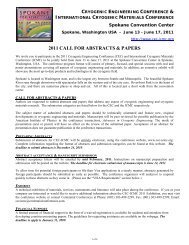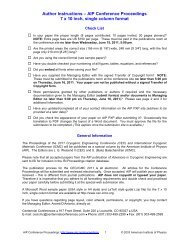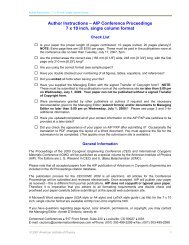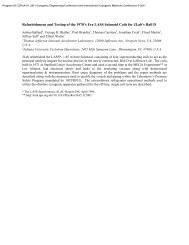CEC Abstracts in PDF format (as of 7/3/07) - CEC-ICMC 2013
CEC Abstracts in PDF format (as of 7/3/07) - CEC-ICMC 2013
CEC Abstracts in PDF format (as of 7/3/07) - CEC-ICMC 2013
You also want an ePaper? Increase the reach of your titles
YUMPU automatically turns print PDFs into web optimized ePapers that Google loves.
<strong>CEC</strong> 20<strong>07</strong> - <strong>Abstracts</strong><br />
C1-P-04 1.8 K refrigeration units for the LHC: conclusion<br />
<strong>of</strong> procurement ph<strong>as</strong>e and first operational experience<br />
G. Ferl<strong>in</strong>, CERN.<br />
The cool<strong>in</strong>g capacity below 2 K for the superconduct<strong>in</strong>g magnets <strong>of</strong><br />
the Large Hadron Collider (LHC) is provided by eight refrigeration<br />
units <strong>of</strong> 2400 W at 1.8 K, each <strong>of</strong> them coupled to a 4.5 K refrigerator.<br />
After successful test<strong>in</strong>g and acceptance <strong>of</strong> the pre-series units<br />
delivered by the two selected vendors, the 2 pre-series units and the 6<br />
series units were <strong>in</strong>stalled <strong>in</strong> underground cavern at their f<strong>in</strong>al<br />
location. Dur<strong>in</strong>g the l<strong>as</strong>t two years, these 8 units were successfully<br />
tested at their <strong>in</strong>stalled capacity <strong>in</strong> a so-called “capacity check mode”.<br />
After a brief rem<strong>in</strong>der <strong>of</strong> the pre-series commission<strong>in</strong>g tests results, a<br />
statement <strong>of</strong> the tests done at <strong>in</strong>stalled capacity for the eight units will<br />
be reported, with emph<strong>as</strong>is on the reproducibility <strong>of</strong> the results among<br />
the four units supplied by each vendor. Conclusion <strong>of</strong> the procurement<br />
ph<strong>as</strong>e will be drawn with the review <strong>of</strong> the critical po<strong>in</strong>ts that have<br />
been solved. F<strong>in</strong>ally this paper will report on the first operational<br />
experience <strong>of</strong> the units dur<strong>in</strong>g the commission<strong>in</strong>g <strong>of</strong> the LHC sectors<br />
from January 20<strong>07</strong> onwards.<br />
C1-P-05 Design and Manufactur<strong>in</strong>g <strong>of</strong> the KSTAR<br />
Tokamak Helium Refrigeration System<br />
P. Dauguet, P. Briend, I. Abe, E. Fauve, J.M.<br />
Bernhardt, F. Andrieu, J. Beauvisage, Air Liquide.<br />
The KSTAR (Korean Superconduct<strong>in</strong>g Tokamak Advanced Research)<br />
project makes <strong>in</strong>tensive use <strong>of</strong> superconduct<strong>in</strong>g magnets operated at<br />
4.4 K. The cold components <strong>of</strong> KSTAR require forced flow <strong>of</strong><br />
supercritical helium for magnets and structure, boil<strong>in</strong>g liquid helium<br />
for current leads, and g<strong>as</strong>eous helium for thermal shields. A helium<br />
refrigeration system h<strong>as</strong> been customed design for this project. The<br />
purpose <strong>of</strong> this paper is to give a brief overview <strong>of</strong> the proposed<br />
cryogenic system. The thermal loads specified to the refrigerator <strong>in</strong><br />
the different operat<strong>in</strong>g modes <strong>of</strong> the KSTAR tokamak will be<br />
presented. This specification results <strong>in</strong> the def<strong>in</strong>ition <strong>of</strong> a design mode<br />
for the refrigerator. The design and construction <strong>of</strong> the result<strong>in</strong>g 9 kW<br />
at 4.5 K Helium Refrigeration System will be presented.<br />
C1-P-06 Adopted methodology for cool-down <strong>of</strong> SST-1<br />
superconduct<strong>in</strong>g magnet system: Operational experience<br />
with the helium refrigerator<br />
A.K. Sahu, B. Sarkar, P. Panchal, J. Tank, R.<br />
Bhattacharya, R. Panchal, V.L. Tanna, R. Patel, P.<br />
Shukla, J.C. Patel, M. S<strong>in</strong>gh, D. Sonara, R. Sharma, R.<br />
Duggar, Y.C. Saxena, Institute for pl<strong>as</strong>ma research.<br />
The 1.3 kW @ 4.5 K helium refrigerator/liquefier (HRL) h<strong>as</strong> been<br />
commissioned dur<strong>in</strong>g year 2003 and s<strong>in</strong>ce then the HRL is <strong>in</strong><br />
operation for different experiments. The HRL h<strong>as</strong> been operated with<br />
its different modes <strong>as</strong> per the functional requirements <strong>of</strong> the<br />
experiments. The recent experience <strong>of</strong> cool<strong>in</strong>g down the magnet<br />
system (SCMS) <strong>of</strong> SST-1 with 16 nos. <strong>of</strong> toroidal field magnets and 9<br />
nos. <strong>of</strong> poloidal field magnets h<strong>as</strong> been unique. The cool-down<br />
experiment <strong>of</strong> the SCMS h<strong>as</strong> been carried out under physical<br />
parameter constra<strong>in</strong>ts with not so appreciable vacuum <strong>in</strong>side the<br />
cryostat <strong>as</strong> well <strong>as</strong> uneven temperature distribution on the thermal<br />
shield at 80 K. Successful attempt h<strong>as</strong> been made to cool the SCMS<br />
down to 4.5 K. The experience h<strong>as</strong> been unique <strong>as</strong> new<br />
thermodynamic balance <strong>of</strong> the refrigerator had to be adjusted with the<br />
orig<strong>in</strong>al boundary condition <strong>of</strong> the HRL. The enhanced capacity w<strong>as</strong><br />
achieved without any additional hardware. The control system <strong>of</strong> the<br />
HRL w<strong>as</strong> tuned manually to achieve the stable thermodynamic<br />
balance, while keep<strong>in</strong>g the turb<strong>in</strong>e operat<strong>in</strong>g parameters at optimized<br />
condition. Extra m<strong>as</strong>s flow rate requirement h<strong>as</strong> been met by<br />
exploit<strong>in</strong>g the marg<strong>in</strong> available with the compressor station. The paper<br />
will describe the methodology adopted to modify the capacity <strong>of</strong> HRL<br />
with safety precaution and experience <strong>of</strong> SCMS cool down to 4.5 K.<br />
The operational experience along with control system <strong>of</strong> the HRL will<br />
be discussed.<br />
C1-P-<strong>07</strong> The Relativistic Heavy Ion Collider (RHIC)<br />
Cryogenic System at Brookhaven National Laboratory:<br />
Review <strong>of</strong> the Modifications and Upgrades s<strong>in</strong>ce 2002 and<br />
Planned Improvements<br />
Y.R. Than, J. Tuozzolo , Brookhaven National<br />
Laboratory; A. Sidi-Yekhlef, V. Ganni, P. Knudsen, D.<br />
Arenius, Thom<strong>as</strong> Jefferson National Accelerator<br />
Facility.<br />
An ongo<strong>in</strong>g program at Brookhaven National Laboratory consists <strong>of</strong><br />
improv<strong>in</strong>g the operational efficiency, reliability and stability <strong>of</strong> the<br />
cryogenic system which also resulted <strong>in</strong> improved beam quality <strong>of</strong> the<br />
Relativistic Heavy Ion Collider.<br />
This paper presents a summary <strong>of</strong> the changes made over the four<br />
years and the proposed improvements for the future. The work w<strong>as</strong><br />
carried out <strong>in</strong> several ph<strong>as</strong>es by balanc<strong>in</strong>g the accelerator’s schedule<br />
<strong>of</strong> operation, time required for the modifications and budget<br />
constra<strong>in</strong>ts. The ma<strong>in</strong> changes <strong>in</strong>clude process control, oil removal,<br />
pip<strong>in</strong>g, elim<strong>in</strong>ation <strong>of</strong> the use <strong>of</strong> cold compressors, reduction <strong>in</strong> liquid<br />
storage, provid<strong>in</strong>g additional multi layer <strong>in</strong>sulation on the <strong>in</strong>-use<br />
liquid helium reservoirs, and the addition <strong>of</strong> a load “wet” turb<strong>in</strong>e and<br />
its <strong>as</strong>sociated heat exchangers at the low temperature end <strong>of</strong> the plant.<br />
Changes were also made to the cryogenic flow configuration to<br />
elim<strong>in</strong>ate the use <strong>of</strong> the liquid helium circulators used to circulate the<br />
sub-cooled helium through the magnet loops. Future upgrades <strong>in</strong>clude<br />
the resiz<strong>in</strong>g <strong>of</strong> turb<strong>in</strong>es 5 and 6 to <strong>in</strong>cre<strong>as</strong>e their efficiencies.<br />
The paper summarizes the work done to date and the progression <strong>of</strong><br />
improvements after each upgrade ph<strong>as</strong>e, start<strong>in</strong>g from the <strong>in</strong>itial 9.3<br />
MW power usage level to the present 6 MW and the expected level<br />
below 5 MW after the completion <strong>of</strong> the rema<strong>in</strong><strong>in</strong>g improvements.<br />
C1-P-08 An Overview <strong>of</strong> the Planned Jefferson Lab<br />
12GeV 2.1 K Helium Refrigerator<br />
D. Arenius, J. Creel, K. Dixon, V. Ganni, P. Knudsen,<br />
A. Sidi-Yekhlef, M. Wright, , Jefferson Laboratory.<br />
The US Department <strong>of</strong> Energy (DOE) h<strong>as</strong> placed Jefferson Lab <strong>in</strong><br />
Newport News, Virg<strong>in</strong>ia, on a path towards a major upgrade <strong>of</strong> the<br />
Cont<strong>in</strong>uous Electron Beam Accelerator Facility (CEBAF). In April<br />
2005, the DOE announced "critical decision zero" (CD-0) for the<br />
laboratory`s proposal to double the superconduct<strong>in</strong>g accelerator`s<br />
energy from 6 to 12 GeV, add a fourth experimental hall and upgrade<br />
equipment <strong>in</strong> the three exist<strong>in</strong>g halls. This step established the<br />
"mission need" and moves the upgrade <strong>in</strong>to a formal project-def<strong>in</strong>ition<br />
ph<strong>as</strong>e. In February 2006, the DOE Office <strong>of</strong> Science approved<br />
“critical decision 1” (CD-1) status for the project.<br />
Operat<strong>in</strong>g cont<strong>in</strong>uously s<strong>in</strong>ce 1993, the Jefferson Lab’s current 2.1 K<br />
4600W Central Helium Liquefier (CHL) capacity will be doubled to<br />
support the upgrade. An overview <strong>of</strong> the <strong>in</strong>tegration <strong>of</strong> the new<br />
proposed refrigeration system <strong>in</strong>to CEBAF will be presented <strong>in</strong>clusive<br />
<strong>of</strong> planned work scope, current schedule plans and project status.<br />
This work is supported under DOE Contract Number DE-AC05-<br />
06OR-23177<br />
Page 18 <strong>of</strong> 53






